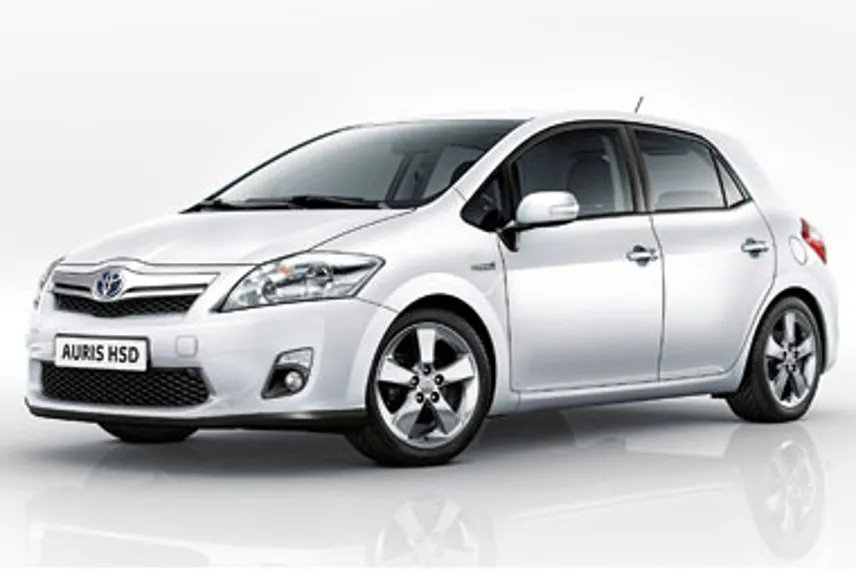Review
Put in its natural habitat – urban routes and city centres – the new Auris HSD (Hybrid Synergy Drive) is superb.
But company car drivers will have to be shown how to get the best out of this 89g/km CO2-emitting electric-petrol car if they want to achieve the 74.3mpg fuel consumption figure.
Consider the evidence based on our test drive: Route A, consisting of 100 miles of fast A-roads, motorways, steep hills and an overworked engine. Result 44mpg.
Step in Toyota’s engineering experts with their advice about how to best drive the car for maximum efficiency.
It consists of understanding the dials to keep the needle in the electric zone (EV mode is possible at speeds up to 30mph and continuously for up to two miles) or electric/petrol combined where the engine is at its most efficient (eco mode).
The trick is to stay away from power mode where the 1.8-litre engine takes over.
On to route B, then, consisting of 40 miles of brief motorway, urban routes and city centre congestion. Sensible driving following Toyota’s advice led to a smooth journey at a decent pace.
Result: 78mpg, exceeding Toyota’s own figures by almost 4mpg.
And a full four-star ‘excellent’ rating at the end of the journey (each trip gets graded by the on-board computer).
This isn’t a car for reps travelling hundreds of motorway miles.
But it’s perfect for commuters who spend most of their working lives in and around town and city centres, although it’s worth noting that the best CO2/mpg achieved figures are on the 15-inch wheels. Upgrade to 17-inch and CO2 rises to 93g/km while fuel efficiency dips to 70.6mpg.
Toyota is eager to get this car out into the market (it goes on sale on July 1). It recognises that most buyers will not be ‘electric evangelists’, the type of people who would plump for the hybrid-only Prius.
Fleets – user-choosers will account for half the 7,250 sales next year (HSD will account for 40% of all Auris sales).
One in four people who consider, then reject, the Prius go on to buy a C-sector car: it’s these people that Toyota aims to capture with the HSD.
The fleet proposition looks good. Priced from £18,950, with an eight-year/100,000-mile battery warranty, the Auris HSD attracts 100% year-one writing-down allowance, zero congestion charge and no road tax. BIK tax is the minimum 10%.
Toyota predicts service and maintenance costs of £1,183 over 60,000 miles, compared to £1,475 for the Volkswagen Golf SE 2.0 TDI.
Residuals have been set at 35% by CAP; the Golf is 40% but costs £1,000 more.
John Thompson, marketing director, claims fleets would save £700 on fuel over 60,000 miles compared to the Golf and £1,168 over the Ford Focus, while company car drivers would save more than £2,000 on tax.
Redesign touches produce a bulkier new look compared to the traditional Auris, which is deceptive because the car is more aerodynamic with a low co-efficient drag of 0.28.
Low rolling resistance tyres and aerodynamic bumpers, alloy wheels and roof spoiler assist the HSD’s efficiency performance.
Practicality is still an issue. The battery pack takes up the majority of the boot space, leaving just 279 litres – room for a couple of small bags. But that shouldn’t detract from its primary role as an outstanding urban cruiser.
Specs
| Manufacturer | Toyota |
| Model | Auris |
| Specification | |
| Model Year | 0.00 |
| Annual VED (Road tax) | £0 |
| BIK List Price | £19,490 |
| CO2 | 89g/km |
| BIK Percentage | 10% |
| Insurance Group | N/A |
| CC | N/A |
| Fuel Type | Petrol Hybrid |
| Vehicle Type | |
| Luggage capacity (Seats up) | N/A |
Running Costs
| P11D | £19,490 |
| Cost per mile | 31.87ppm |
| Residual value | £6,325 |
| Insurance group | N/A |
| Fuel Type | Petrol Hybrid |
| Cost per mile | 0.00ppm |
| Fuel | 0.00ppm |
| Depreciation | 0.00ppm |
| Service maintenance and repair | 0.00ppm |
Info at a glance
-
P11D Price
£19,490
-
MPG
74.3 -
CO2 Emissions
89g/km -
BIK %
10% -
Running cost
3 Year 60k : 31.87 4 Year 80k : £4,725 -
Fuel Type
Petrol Hybrid



















